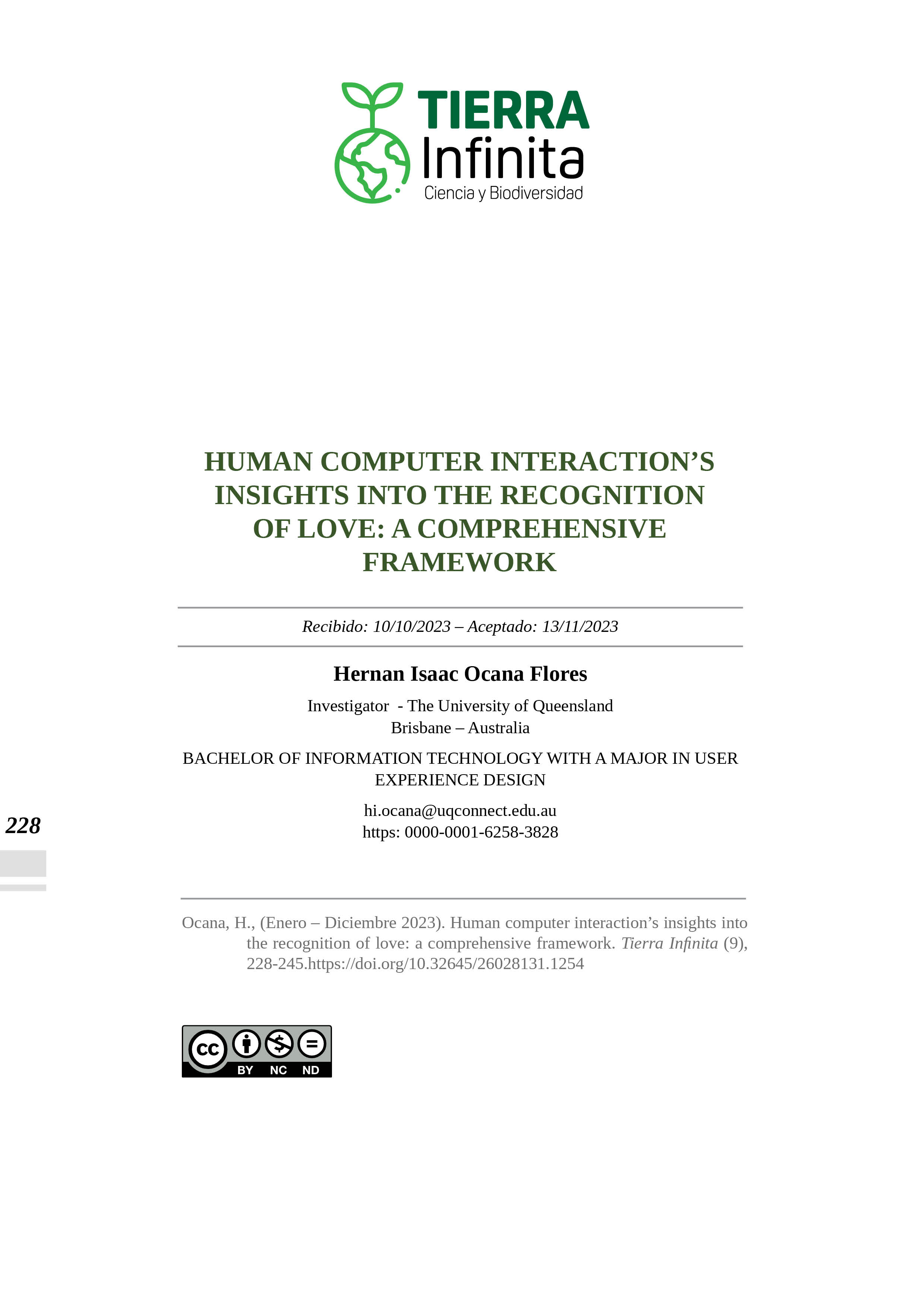Human Computer Interaction’s insights into the Recognition of Love: A Comprehensive Framework
DOI:
https://doi.org/10.32645/26028131.1254Palabras clave:
Human Computer Interaction, Emotional technology, Dynamic Feedback Loop, Emotion Regulation, Artificial IntelligenceResumen
This framework considers complex emotions that can be analysed by various current technological techniques, measures, and resources available nowadays. The author postulates an evolving feedback mechanism between man’s psyche and technology development which defines man’s psychological condition as well. The dimensions of the dynamic feedback loop comprise of affective communication via technology, recognition of emotions through technology, and moderation of emotions using technology. Thought the exploration of love other possibilities for theoretical frames of system development, and systems’ needs for other emotions. Using emotion recognition technology (e.g., facial expression analysis) and sentiment analysis, these devices can recognise the users’ emotions, thereby making it possible for designers to develop user-centred designs. What makes emotional technologies exist is the requirement of combining the technologies which are highly precise and can understand the complicated traits of life. Finally, the importance of emotional technologies advancements is discussed as t is now essential to unify these technologies to reach unprecedented accuracies and studying the highest complexity of life phenomena.
Referencias
Aron, A., Fisher, H. E., Mashek, D. J., Strong, G., Li, H., & Brown, L. L. (2005). Reward, motivation, and emotion systems associated with early-stage intense romantic love. Journal of Neurophysiology, 94(1), 327-337. Retrieved from: https://pubmed.ncbi.nlm.nih.gov/15928068/
Barrett, L. F., Mesquita, B., & Gendron, M. (2011). Context in emotion perception. Current Directions in Psychological Science, 20(5), 286-290. Retrieved from: https://journals.sagepub.com/doi/10.1177/0963721411422522
Batson, C. D., & Shaw, L. L. (1991). Evidence for altruism: Toward a pluralism of prosocial motives. Psychological Inquiry, 2(2), 107-122. Retrieved from: https://psycnet.apa.org/record/1992-01389-001
Bazarova, N. N., & Choi, Y. H. (2014). Self-disclosure in social media: Extending the functional approach to disclosure motivations and characteristics on social network sites. Journal of Communication, 64(4), 635-657. Retrieved from: https://www.researchgate.net/publication/264792898_Self-Disclosure_in_Social_Media_Extending_the_Functional_Approach_to_Disclosure_Motivations_and_Characteristics_on_Social_Network_SitesAn_earlier
Bowlby, J. (1969). Attachment and loss: Vol. 1. Attachment. Basic Books.
Broekens, J., Brinkman, W. P., & Heylen, D. (2011). The impact of perceiving affective body language and facial expressions on the perception of emotions in virtual characters. International Journal of Human-Computer Studies, 69(11), 870-878.
Buolamwini, J., & Gebru, T. (2018). Gender shades: Intersectional accuracy disparities in commercial gender classification. In Proceedings of the 1st Conference on Fairness, Accountability and Transparency (pp. 77-91). Retrieved from: https://proceedings.mlr.press/v81/buolamwini18a.html
Cambria, E., & Hussain, A. (2015). Sentic computing: A common-sense-based framework for concept-level sentiment analysis. IEEE Transactions on Cybernetics, 45(3), 612-626. Retrieved from: https://www.researchgate.net/publication/280734667_Sentic_Computing_A_Common-Sense-Based_Framework_for_Concept-Level_Sentiment_Analysis
Chan, A. D. C., & Lievens, F. (2019). Wearable Technology and Embodied Accounts: An Integrative Review. Organizational Research Methods, 22(2), 475-509.
Subramani P., Chuon, Y. H., Lee, Y. R., & Aaseer, Y. S. (2017). Smartphone usage and increased risk of mobile phone addiction: A concurrent study. International Journal of Psychiatry in Clinical Practice, 21(3), 183-188. Retrieved from: https://www.ncbi.nlm.nih.gov/pmc/articles/PMC5680647/
Consolvo, S., McDonald, D. W., Toscos, T., Chen, M. Y., Froehlich, J., Harrison, B., ... & Klasnja, P. (2008). Activity sensing in the wild: A field trial of ubifit garden. In Proceedings of the SIGCHI Conference on Human Factors in Computing Systems (pp. 1797-1806). Retrieved from: https://www.researchgate.net/publication/221518229_Activity_Sensing_in_the_Wild_A_Field_Trial_of_UbiFit_Garden
Cooper, A., Reimann, R., & Cronin, D. (2007). About face 3: The essentials of interaction design. John Wiley & Sons. Retrieved from: https://books.google.com.ec/books?id=e75G0xIJju8C&printsec=frontcover&source=gbs_ge_summary_r&cad=0
Cowley, B., Charles, D., Black, M., & Hickey, R. (2008). Toward an emotion sensitive world. IEEE Transactions on Computational Intelligence and AI in Games, 1(4), 74-87.
De Choudhury, M., Kıcıman, E., Dredze, M., Coppersmith, G., & Kumar, M. (2016, February). Discovering shifts to suicidal ideation from mental health content in social media. In Proceedings of the 2016 CHI Conference on Human Factors in Computing Systems (pp. 2098-2110).
D'Mello, S. K., & Graesser, A. C. (2012). AutoTutor and affective autotutor: Learning by talking with cognitively and emotionally intelligent computers that talk back. ACM Transactions on Interactive Intelligent Systems (TiiS), 2(4), 23.
Dworkin, J. D., Connell, I. D., & Doty, J. (2018). A typology of ethical issues in qualitative research. Qualitative Psychology, 5(2), 165-180.
Eastwick, P. W., & Finkel, E. J. (2008). Speed-dating. Current Directions in Psychological Science, 17(3), 193-197.
Fiore, A. T., Taylor, L. S., Mendelsohn, G. A., & Hearst, M. (2008). Assessing attractiveness in online dating profiles. In Proceedings of the SIGCHI Conference on Human Factors in Computing Systems (pp. 797-806).
Fisher, H. E., Aron, A., Mashek, D. J., Li, H., & Brown, L. L. (2002). Defining the brain systems of lust, romantic attraction, and attachment. Archives of Sexual Behavior, 31(5), 413-419.
Gaggioli, A., Pallavicini, F., Morganti, L., Serino, S., Scaratti, C., Briguglio, M., ... & Riva, G. (2017). Experiential virtual scenarios with real-time monitoring (interreality) for the management of psychological stress: A block randomized controlled trial. Journal of Medical Internet Research, 19(3), e92.
Hitsch, G. J., Hortacsu, A., & Ariely, D. (2010). What makes you click?—Mate preferences in online dating. Quantitative Marketing and Economics, 8(4), 393-427.
Kim, J., & Dey, A. K. (2015). Simultaneous modeling of multiple physiological signals for emotion recognition. In Proceedings of the 2015 ACM International Joint Conference on Pervasive and Ubiquitous Computing (pp. 699-710).
Kivikangas, Ekman, I., Järvelä, S., & Ravaja, N. (2020). Stimulus Games, retrieved from: https://www.researchgate.net/publication/346387331_Stimulus_Games?_tp=eyJjb250ZXh0Ijp7ImZpcnN0UGFnZSI6Il9kaXJlY3QiLCJwYWdlIjoicHJvZmlsZSJ9fQ#full-text
Kivikangas, J. M., Chanel, G., Cowley, B., Ekman, I., Salminen, M., Järvelä, S., & Ravaja, N. (2011). A review of the use of psychophysiological methods in game research. Journal of Gaming & Virtual Worlds, 3(3), 181-199, American Psychological Association. Retrieved from: https://doi.org/10.1386/jgvw.3.3.181_1
Liu, B. (2012). Sentiment analysis and opinion mining. Synthesis Lectures on Human Language Technologies, 5(1), 1-167. Retrieved from: https://doi.org/10.2200/S00416ED1V01Y201204HLT016
Ly, K. H., Trüschel, A., Jarl, L., Magnusson, S., Windahl, T., Johansson, R, & Andersson, G. (2014). Behavioural activation versus mindfulness-based guided self-help treatment administered through a smartphone application: A randomised controlled trial. BMJ Open, 4(1), e003440. Retrieved from: https://bmjopen.bmj.com/content/4/1/e003440.info
Moor, I., Taylor A., Grigor I., Bahameish, Putnam C., Hanschke C., Rana A.,(2019). Can Changes in Heart Rate Variability Represented in Sound be Identified by Non-Medical Experts - HasAnswers: Development of a Digital Tool to Support Young People to Manage Independent Living - Efficacy of Film for Raising Awareness of Diverse Users. Proceedings of the 2019 CHI Conference on Human Factors in Computing Systems (CHI ’19). Retrieved from: https://dl.acm.org/doi/proceedings/10.1145/3290607
Nijholt, A., Reidsma, D., & van Welbergen, H. (2018). Nonverbal and Bodily Interaction in Ambient Entertainment. Japanese Journal of Applied PhysicsRetrieved from : https://www.researchgate.net/publication/228364266_Nonverbal_and_Bodily_Interaction_in_Ambient_Entertainment.
Norman, D. A. (2004). Emotional design: Why we love (or hate) everyday things. Basic books.
Park, N., Jin, B., & Jin, S. A. (2016). Effects of self-disclosure on relational intimacy in Facebook. Computers in Human Behavior, 55, 399-406.
Pennebaker, J. W., & Chung, C. K. (2011). Expressive writing: Connections to physical and psychological health. In The Oxford Handbook of Health Psychology (pp. 417-437).
Picard, R. W. (1997). Affective computing. MIT Media Lab Perceptual Computing Section Technical Report. Retrieved from: https://www.scirp.org/reference/ReferencesPapers?ReferenceID=1714599
Primack, B. A., Shensa, A., Sidani, J. E., Whaite, E. O., Lin, L. Y., Rosen, D., ... & Miller, E. (2017). Social media use and perceived social isolation among young adults in the US. PLOS ONE, 12(8), e0182146. DOI 10.1016/j.amepre.2017.01.010 Retrieved from: https://www.ncbi.nlm.nih.gov/pmc/articles/PMC5722463/
Riva, G., Banos, R. M., Botella, C., Wiederhold, B. K., & Gaggioli, A. (2019). Positive technology and active ageing: The rehabilitation gamification example. Stud Health Technol Inform, 267, 159-165. DOI:10.3233/978-1-61499-425-1-44 Retrieved from: https://www.researchgate.net/publication/268923757_Positive_Technology_for_Healthy_Living_and_Active_Ageing
Rizzo, A. S., Difede, J., Rothbaum, B. O., Reger, G., Spitalnick, J., Cukor, J., ... & Pair, J. (2010). Development and early evaluation of the Virtual Iraq/Afghanistan exposure therapy system for combat-related PTSD. Annals of the New York Academy of Sciences, 1208(1), 114-125. DOI 10.1111/j.1749-6632.2010.05755.x Retrieved from: https://pubmed.ncbi.nlm.nih.gov/20955333/
Rosenfeld, M. J., & Thomas, R. J. (2012). Searching for a mate: The rise of the Internet as a social intermediary. American Sociological Review, 77(4), 523-547. Retrieved from: https://journals.sagepub.com/doi/full/10.1177/0003122412448050
Saeb, S., Zhang, M., Karr, C. J., Schueller, S. SM., Corden, M. E., Kording, K. P., & Mohr, D. C. (2015). Mobile phone sensor correlates of depressive symptom severity in daily-life behavior: an exploratory study. Journal of Medical Internet Research, 17(7), e175. DOI 10.2196/jmir.4273 Retrieved from: https://pubmed.ncbi.nlm.nih.gov/26180009/
Shiffman, S., Stone, A. A., & Hufford, M. R. (2008). Ecological momentary assessment. Annual Review of Clinical Psychology, 4, 1-32. Retrieved from:https://www.annualreviews.org/doi/abs/10.1146/annurev.clinpsy.3.022806.091415
Tika Adilah1, Supendar H., Ningsih R., Muryani S., and Solecha K., (2021). Sentiment Analysis of Online Transportation Service using the Naïve Bayes Methods, Journal of Physics: Conference Series. DOI 10.1088/1742-6596/1641/1/012093 Retrieved from: https://iopscience.iop.org/article/10.1088/1742-6596/1641/1/012093
Toma, C. L., Hancock, J. T., & Ellison, N. B. (2008). Separating fact from fiction: An examination of deceptive self-presentation in online dating profiles. Personality and Social Psychology Bulletin, 34(8), 1023-1036. Retrieved from: https://doi.org/10.1177/0146167208318067
Verduyn, P., Ybarra, O., Résibois, M., Jonides, J., & Kross, E. (2017). Do social network sites enhance or undermine subjective well-being? A critical review. Social Issues and Policy Review, 11(1), 274-302. Retrieved from: https://doi.org/10.1111/sipr.12033

Publicado
Número
Sección
Licencia
Derechos de autor 2023 Hernan Isaac Ocana Flores

Esta obra está bajo una licencia internacional Creative Commons Atribución-NoComercial-SinDerivadas 4.0.
El autor mantiene los derechos intelectuales y morales de su obra, autorizando a la editorial de la Revista Tierra Infinita la difusión y divulgación de su contenido con fines estrictamente académicos y de investigación, sin fines de lucro.










